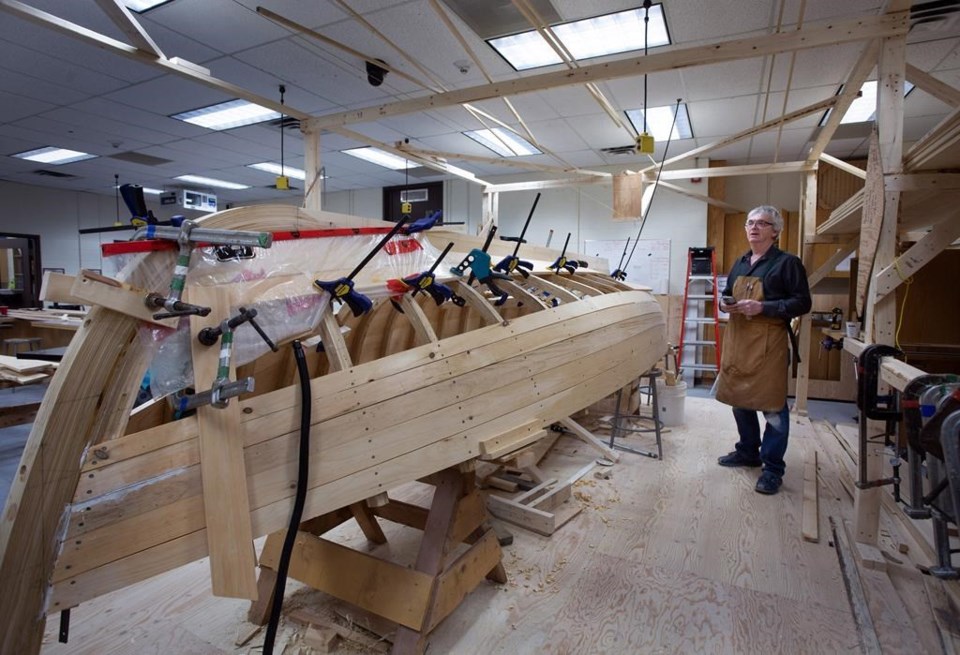ST. JOHN'S, N.L. — There are many reasons a dozen people gathered two evenings a week this year in St. John's to build a traditional Newfoundland boat, bending and clamping long planks of wood and handling high-strength industrial glue.
Some, like John Handrigan of Placentia Junction, N.L., were drawn in by the history and felt a connection to the centuries of fishermen who had built similar boats — though without the help of power saws and Bostik 920FS marine sealant.
Others wanted to learn to build their own boats or had already started. Derrick Cove was constructing a vessel in a garage outside St. John's, in tandem with the class.
"I'm retired, I don't like sitting down and I want to try to retain some of my Newfoundland culture," he explained during a class late last month.
And some enrolled to learn basic carpentry skills.
"There aren't a lot of options for amateur, recreational woodworking learning," said Ellen Davis, who works in public relations.
She laughed about running out of her office to be on time for her "boat course."
"It's really fun, and now at the end, we have this really cool project."
The 12-week course is offered through the Wooden Boat Museum of Newfoundland and Labrador in a wide, bright classroom at Memorial University. From January to late March, students built a 16-foot-long traditional wooden fishing boat, called a punt, or a rodney.
They began by laminating long strips of wood together to form the vessel's keel, which runs the length of the craft from stern to bow. By late January, they had added the punt's distinctively flat rear end, with its small planks running perpendicular to the keel below. And in late March, they were steaming and bending long, smile-shaped planks to fasten over the hull.Â
Instructor Jerome Canning, the museum's resident wooden boat builder, weaved bits of historical context into his demonstrations, explaining how in the past fishermen would use simple geometry to build boats, since they didn't have tapes or rulers.
"This is from my great-uncle's tool box. It could be 100 years old," Canning said in a late-January class, holding up a planing tool made of rusted black metal.Â
Once completed, the vessel is seaworthy and offered to the students for purchase, said Jim Dempsey, the museum's president. They typically sell for about $5,000, and there have been bidding wars in the past among course participants, he said.Â
Punts and dories — another well-known Newfoundland and Labrador wooden fishing boat — can still be seen in outport communities, often painted in bright primary colours. Some fishermen use signature colours, particularly on the gunnels — or top rails — of the boat. Dempsey's personal hallmark hue is forest green.
The 12-week course was first held in 2017, and several students have since gone on to construct their own boats, Dempsey said. The students often become close, and after they complete the course they follow each other's progress on personal carpentry projects.
Ken Snelgrove, a retired Memorial University engineering professor, took the course with the museum in 2018. He loved it so much, he joined the museum's board of directors and vowed to build a punt of his own, though he admits he hasn't made much headway.
"I've tinkered with my own design, but haven't really got a material start yet," he said.
Snelgrove goes to every class to help out, joking that he's there to "make sure (the students) don't cut their arms off."
Ellen Davis is not planning to build a boat just yet, but she said the course gave her the skills and confidence to begin building a closet.
"I'm definitely more comfortable with things like power tools, which I probably wouldn't have even considered before," she said during a class last month.
This year's cohort has also become close, as Dempsey predicted. Davis said they learned from one another almost as much as they did from Canning.
She said he began the course by telling everyone to be humble and assume they're all beginning with no prior knowledge. That made it safe for those who didn't have building skills, since every question was valued as a learning opportunity, she said.
"It's a really good environment," she said. "I would love another course taught this exact way, in anything at all."
This report by The Canadian Press was first published April 7, 2024.
Sarah Smellie, The Canadian Press



